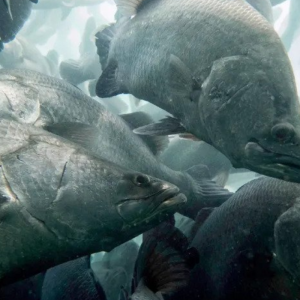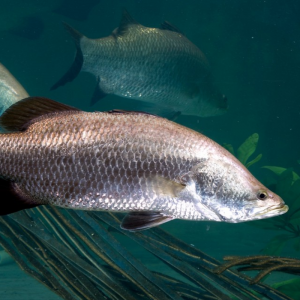
Seaweed Supplementation Shows Delayed Mortality in Farmed Seabass
| Tue, 10 Dec 2019 - 10:28
A new study published in Nature – Scientific Reports find that supplementing aquafeed with Gracilaria gracilis aqueous extract (GRA) enhanced the immune function and antioxidant capacity of European seabass. Researchers also concluded that GRA extract slowed the progression of photobacteriosis infections (Phdp) – making the fish more resistant to the disease.

Seabass aquaculture is becoming more popular, but faces significant challenges from bacterial diseases
The researchers found no difference in the feed intake or weight between experimental and control groups in the trial. This indicates that GRA supplementation could be economically viable and welfare-friendly method of boosting seabass immunity without increasing production costs.
Background
Though European seabass aquaculture is gaining in popularity and profitability, the industry faces significant challenges from bacterial infections. One of the more common infections is Photobacterium damselae subspecies piscicida (Phdp), the causative agent for photobacteriosis. Phdp induces septicemia in young fish and causes massive economic losses from mortalities.
Producers usually rely on prevention instead of treating Phdp outbreaks – it’s more cost-effective to boost fish immunity with supplements instead of vaccinating entire fishponds. Administering supplements is also better for the overall welfare. Delivering immunostimulants through aquafeed means that producers won’t disrupt the surrounding environment or cause handling-related stress.
Nutritional research suggests red seaweeds like Gracilaria gracilis contain polysaccharides that boost fish immunity and slow bacterial growth. There is also evidence that G. gracilis aqueous extract (GRA) acts as a prebiotic in zebrafish (Danio rerio). However, the literature hasn’t established if GRA supplementation is a useful immunostimulant for European seabass.
The study
The researchers wanted to evaluate the effect of GRA in seabass infected with photobacteriosis. More specifically, they wanted to measure how GRA supplementation affected seabass survival rates and immune response after exposure to Phdp.

Young seabass were used to test the efficacy of GRA extract
The researchers began by sourcing seabass fingerlings and acclimating them to experimental tanks for two weeks. During this period, the fish were weighed and fed the same control diet. When the experimental period began, the researchers distributed the fish into eight circular tanks that were connected to a closed seawater RAS, putting 30 individuals into each tank. Four tanks were fed the experimental diet (control + 5 percent GRA extract) and four remained on the control feed. The seabass was tracked for 80 days.
After the observation period, four tanks of fingerlings were experimentally infected with Phdp by injection (two on the control diet, two on the experimental feed). Two tanks were given a placebo injection (one on the control diet and another on the experimental diet). The remaining fish were used as true controls (control diet and no handling for injections). The tanks were taken off the RAS to prevent cross-contamination.
The researchers monitored the seabass for seven days after injection. They recorded feed intake and any mortalities. Kidney samples from the infected fish were collected and examined. The fish were monitored for an additional three days before the experiment concluded.
Results
During the first 80 days of the experiment, the seabass showed no differences in body weight or feed intake. Post-infection however, the groups differed significantly. Seabass that had not been exposed to Phdp had no mortalities and showed no chemical stress response to the experimental environment.

Mortalities were observed on the first day in the control group © Medaid
Fish that were subjected to the disease challenge started succumbing to the infection between one to seven days after exposure. However, seabass fed the GRA-supplemented diet showed better survivability than those fed the control diet. Fish on the control diet succumbed on the first day after exposure whereas it took three days for seabass in the GRA group to become symptomatic and die.
Based on organ and tissue analysis of the seabass fed the experimental diet, researchers concluded that GRA had a de-toxifying effect and helped degrade Phdp bacteria. They also concluded that the fish on the experimental diet had a greater ability to cope with the biological stress of infection when compared to the control group.
Key take-aways
This study provides further evidence of the relationship between diet and immunity in European seabass – usually, improving feed and nutrition quality results in enhanced immune function and a greater ability to resist infection. The results also show that GRA supplementation is effective and economically feasible for producers.
Source: The Fish Site






















